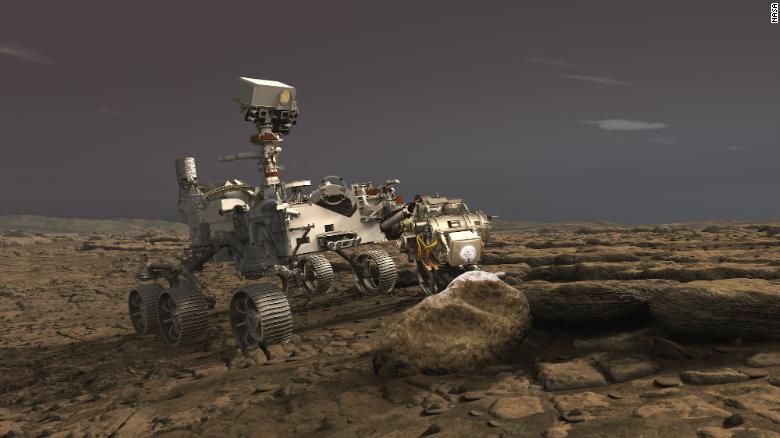(CNN)It's time to go deeper into space.
While 2020 may have derailed and delayed some scientific plans due to the pandemic, 2021 still promises to be a year of science "the likes of which we've rarely seen," according to Thomas Zurbuchen, associate administrator of NASA's Science Mission Directorate.
Multiple missions will explore Mars, new telescopes will begin observations and plans are underway to return humans to the moon by 2024.
The Parker Solar Probe will make its next close approach of the sun in January. The OSIRIS-REx mission will begin its two-year return journey to Earth after successfully collecting a sample of the near-Earth asteroid Bennu. The ongoing NASA Juno mission continues to rewrite what we know about Jupiter and its moons. And scientists will explore and study samples returned from the asteroid Ryugu by Japan's Hayabusa2 mission.
While the pandemic will likely delay the launch and progress of some missions, others remain on track, especially those already in space. Here's what else we can expect in 2021.
Exploring Mars in new ways
It's true that 2020 was the year of multiple missions launching to Mars -- China's Tianwen-1, the United Arab Emirates' Hope Probe and NASA's Perseverance rover -- and 2021 will likely be the year of new discoveries on Mars.
The three missions took advantage of an alignment between Mars and Earth that occurs every 26 months, allowing for quicker and more efficient trips when the two planets are on the same side of the sun.
All three should arrive at Mars in February.
The Hope Probe will go into orbit around Mars, marking the first time the UAE has orbited the red planet. The probe will stay in orbit for a Martian year -- equivalent to 687 days on Earth -- to gather data about Mars' atmosphere.
Tianwen-1, whose name means "Quest for Heavenly Truth," is China's first mission to Mars. The probe will orbit the planet before landing a rover on the surface, with the hope that it can gather important information about the Martian soil, geological structure, environment, atmosphere and signs of water.
Tianwen-1 includes an orbiter, deployable camera, lander and a rover. Once the lander touches down on Mars, it will extend a ramp that allows the rover to roll down to the surface. The orbiter can be used to relay signals from the rover to Earth, and the rover can send messages to Earth on its own.
Perseverance will land on Mars on February 18. The rover is equipped with multiple cameras, including video, as well as microphones, that will hear and record the landing live. NASA expects to have the sound, images and video back on Earth within a few weeks of the landing.
Tucked up beneath the rover is Ingenuity, the first helicopter to fly -- if it succeeds -- on another planet.
Once the rover has landed, Perseverance's two-year mission will begin.
The rover will also find a nice, flat surface to drop the Ingenuity helicopter so it has a place to use as a helipad for its potential five test flights during a 30-day period. This will occur within the first 50 to 90 sols, or Martian days, of the mission.
Once Ingenuity is settled on the surface, Perseverance will drive to a safe spot at a distance and use its cameras to watch and record Ingenuity's flight.
After those flights, Perseverance will begin searching for evidence of ancient life, study Mars' climate and geology and collect samples that will eventually be returned to Earth via planned future missions.
Exploring exoplanets
The much-anticipated James Webb Space Telescope, slated for launch in October, will be NASA's next great space observatory.
However, the telescope's launch has been delayed and pushed several times over the years, and it could face more delays due to the pandemic.
The new target launch date is October 31, 2021. The telescope will launch from French Guiana. Previously scheduled to launch in March 2021, it was delayed by the pandemic and technical challenges, according to the agency.
The telescope will answer questions about our solar system, study exoplanets in new ways and peer deeper into the universe than we've ever been able to before.
It comes equipped with a mirror that can extend 21 feet and 4 inches -- a massive length that will allow the mirror to collect more light from the objects it observes once the telescope is in space. The more light the mirror can collect, the more details the telescope can observe.
It's the largest mirror NASA has ever built, the agency said, but its size created a unique problem. The mirror was so large that it couldn't fit inside a rocket. So they designed the telescope as a series of moving parts that can fold origami-style and fit inside a 16-foot space for launch.
"Webb is designed to build upon the incredible legacies of the Hubble and Spitzer space telescopes, by observing the infrared universe and exploring every phase of cosmic history," said Eric Smith, NASA Webb's program scientist at the agency's headquarters, in a statement.
"The observatory will detect light from the first generation of galaxies that formed in the early universe after the big bang and study the atmospheres of nearby exoplanets for possible signs of habitability."
Vera Rubin's 'first light'
When the Vera C. Rubin Observatory begins observations in 2023 from its base in Chile, its SUV-size camera will be able to capture complete panoramas of the southern sky every few nights. That requires a new type of camera never seen before.
It's the world's largest digital camera, able to spot a golf ball from 15 miles away while capturing stunning 3,200-megapixel images.
The "first light" of the observatory is expected in 2021. First light is the first astronomical image captured by a telescope after it is completed.
The observatory's capabilities will enable it to spot faint objects 100 million times dimmer than what we can see with the naked eye. It's designed to map the Milky Way, explore dark energy and dark matter, and survey the solar system.
During the 10-year survey, the camera is expected to image 20 billion galaxies.
Rubin, who died in 2016, once mentored fellow aspiring female astronomers and advocated for women in science. Considered to be one of the world's most influential astronomers, Rubin provided some of the first evidence that dark matter -- which comprises much of the universe but can't be seen -- existed.
The camera is currently being assembled, and the team estimated that the camera will be ready for testing by mid-2021 before it's sent off to Chile to be installed.
Artemis: A new space generation
The NASA Artemis program, which seeks to land the first woman and the next man on the moon in 2024, made great strides last year despite the pandemic. And 2021 will likely see more advances and milestones for the program.
The milestones achieved for the Artemis program thus far include the introduction of the Artemis Accords and signing by other nations; the completion of the core stage of the SLS rocket and Orion crew capsule that will carry Artemis astronauts to space; and progress on the Gateway lunar outpost that will help astronauts land on the moon.
The first team of 18 Artemis astronauts was also announced, and it's a diverse group that includes some new to NASA as well as veterans of spaceflight.
The astronauts will explore the moon's south pole, with a focus on conducting experimental science and learning more about the origin of water on the moon among other science goals.
While the first Artemis mission in November 2021 will be an uncrewed flight test, Artemis II will be a crewed flyby of the moon in August 2023.
Those missions will pave the way for Artemis III -- when astronauts return to the surface of the moon.
NASA's Volatiles Investigating Polar Exploration Rover, or VIPER, will create the first water resource maps of the moon for future human space exploration once it lands on the lunar surface in 2022.
An Artemis Base Camp could be established at the lunar south pole by the end of the decade.










